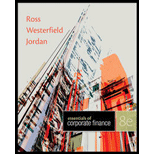
a)
To calculate: The new shares.
Introduction:
A unit of ownership in various investments which fetches an equal distribution is termed as shares.
a)
Answer to Problem 4QP
New number of shares is 4,500.
Explanation of Solution
Given information:
T Company sells the shares at the rate of $42 per share and declared 10% stock dividend. The owner’s total equity shows common stock ($1 par value) of $45,000, capital surplus of $125,000,
Formulae:
The formula to calculate the new shares:
The formula to calculate the new number of outstanding shares:
Compute the new number of shares of F Company:
The common stock is $45,000 at par value of $1.
Therefore, the share value is,
Hence, the existing shares are 45,000.
Note: The Company declares 10% of stock dividend.
Hence, the new number of outstanding shares is 49,500.
Compute the number of new shares:
Hence, the new numbers of shares are 4,500.
To discuss: The changes in equity account.
Introduction:
A unit of ownership in various investments which fetches an equal distribution is termed as shares.
Explanation of Solution
Given information:
T Company sells the shares at the rate of $42 per share and declared 10% stock dividend. The owner’s total equity shows common stock ($1 par value) of $45,000, capital surplus of $125,000, retained earnings of $580,000 and total owners equity of $750,000. (Refer above part) New number of outstanding stock is 49,500. New number of shares is 4,500.
Compute the change in values of total owner’s equity:
Compute the change in value of common stock:
Hence, the new common stock is $49,500.
Compute the change in value of capital surplus:
Note: The new share par value is $1, so the capital surplus is
Hence, the new capital surplus is $184,500.
Compute the total owner’s equity:
| Particulars | Amount |
| ($) | |
| Common stock ($1 par value) | $49,500 |
| Capital surplus | $309,500 |
| ($184,500+$125,000) | |
| Retained earnings (b/f) | $391,000 |
| Total Owner's equity | $750,000 |
Note: Retained earnings will remain as balancing figure in the owner’s equity.
Hence, the total owner’s equity is $750,000.
b)
To calculate: Total owner’s equity, when the company declares 25% stock dividend.
Introduction:
A unit of ownership in various investments which fetches an equal distribution is termed as shares.
b)
Explanation of Solution
Given information:
T Company sells the shares at the rate of $42 per share and declared 10% stock dividend. The owner’s total equity shows common stock ($1 par value) of $45,000, capital surplus of $125,000, retained earnings of $580,000 and total owners equity of $750,000. (Refer above part) New number of outstanding stock is 49,500. New number of shares is 4,500.
Formulae:
The formula to calculate the new number of shares:
The formula to calculate the new number of outstanding shares:
Compute the new number of shares of T Incorporation, when it declares 25% stock dividend:
Hence, the new number of outstanding shares is 56,250.
New shares:
Hence, the new number of share is 11,250.
Compute the change in values of total owner’s equity:
Compute the change in value of common stock:
Hence, the new common stock is $56,250.
Note: The new share par value is $1, so the capital surplus is
Hence, the new capital surplus is $461,250.
Compute the total owner’s equity:
| Particulars | Amount |
| ($) | |
| Common stock ( $1par value) | $56,250 |
| Capital surplus | $586,250 |
| ($461,250+$125,000) | |
| Retained earnings | $107,500 |
| (b/f) | |
| Total Owner's equity | $750,000 |
Note: Retained earnings will remain as balancing figure in the owner’s equity.
Hence, the total owner’s equity is $750,000.
Want to see more full solutions like this?
Chapter 14 Solutions
Essentials of Corporate Finance
 Essentials Of InvestmentsFinanceISBN:9781260013924Author:Bodie, Zvi, Kane, Alex, MARCUS, Alan J.Publisher:Mcgraw-hill Education,
Essentials Of InvestmentsFinanceISBN:9781260013924Author:Bodie, Zvi, Kane, Alex, MARCUS, Alan J.Publisher:Mcgraw-hill Education,

 Foundations Of FinanceFinanceISBN:9780134897264Author:KEOWN, Arthur J., Martin, John D., PETTY, J. WilliamPublisher:Pearson,
Foundations Of FinanceFinanceISBN:9780134897264Author:KEOWN, Arthur J., Martin, John D., PETTY, J. WilliamPublisher:Pearson, Fundamentals of Financial Management (MindTap Cou...FinanceISBN:9781337395250Author:Eugene F. Brigham, Joel F. HoustonPublisher:Cengage Learning
Fundamentals of Financial Management (MindTap Cou...FinanceISBN:9781337395250Author:Eugene F. Brigham, Joel F. HoustonPublisher:Cengage Learning Corporate Finance (The Mcgraw-hill/Irwin Series i...FinanceISBN:9780077861759Author:Stephen A. Ross Franco Modigliani Professor of Financial Economics Professor, Randolph W Westerfield Robert R. Dockson Deans Chair in Bus. Admin., Jeffrey Jaffe, Bradford D Jordan ProfessorPublisher:McGraw-Hill Education
Corporate Finance (The Mcgraw-hill/Irwin Series i...FinanceISBN:9780077861759Author:Stephen A. Ross Franco Modigliani Professor of Financial Economics Professor, Randolph W Westerfield Robert R. Dockson Deans Chair in Bus. Admin., Jeffrey Jaffe, Bradford D Jordan ProfessorPublisher:McGraw-Hill Education





